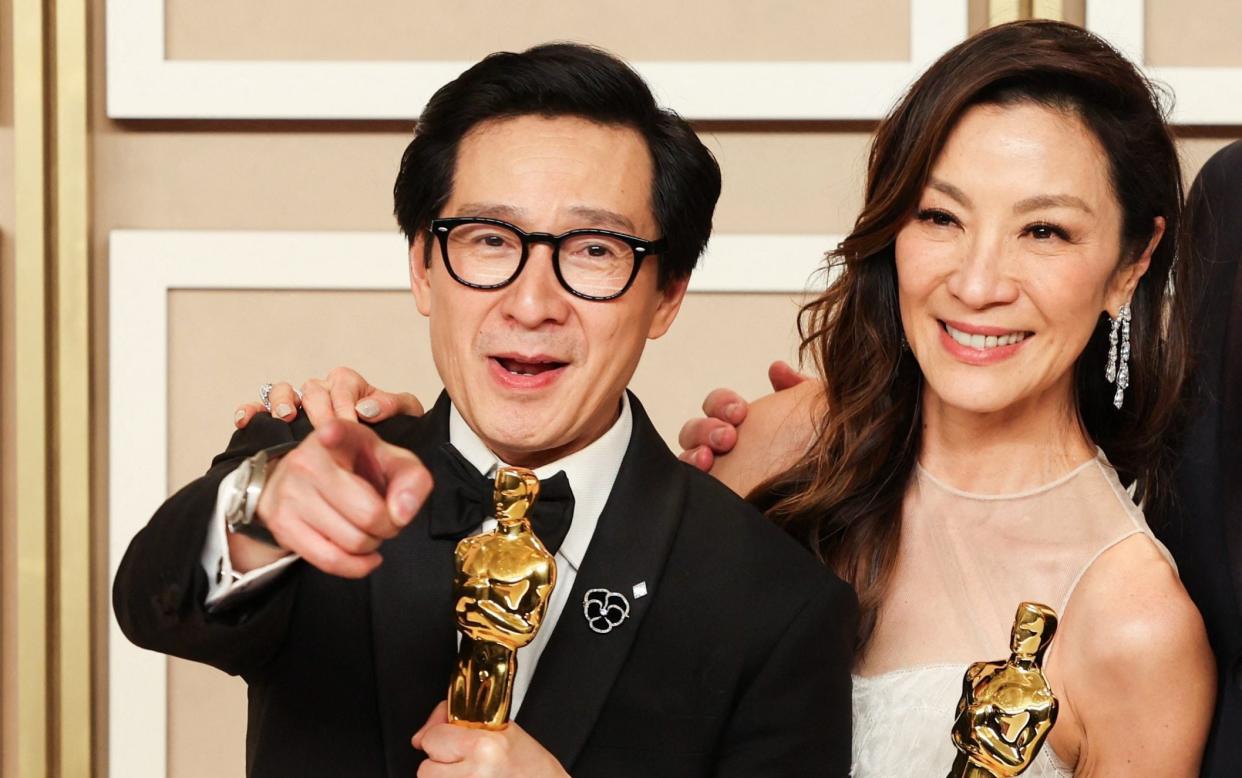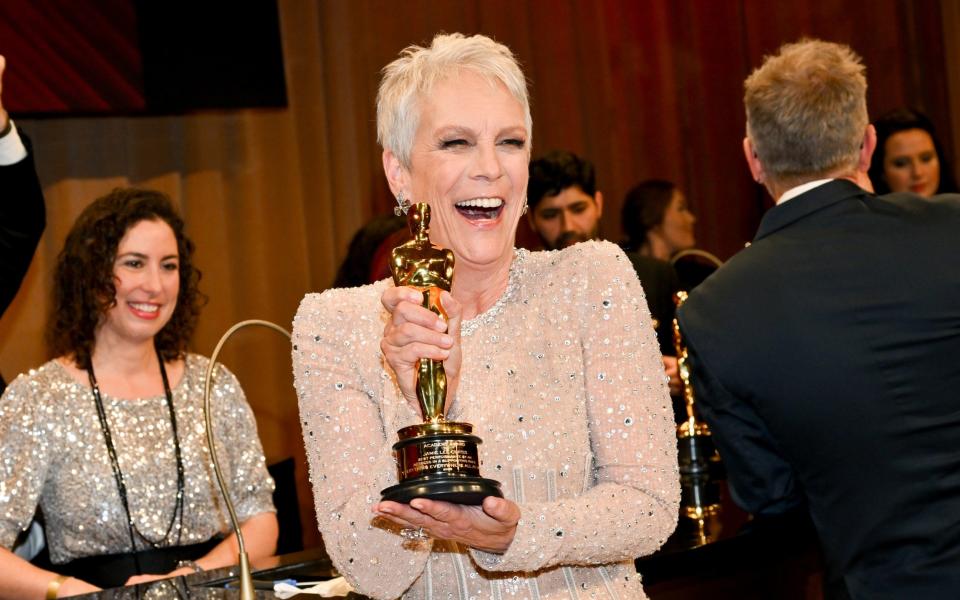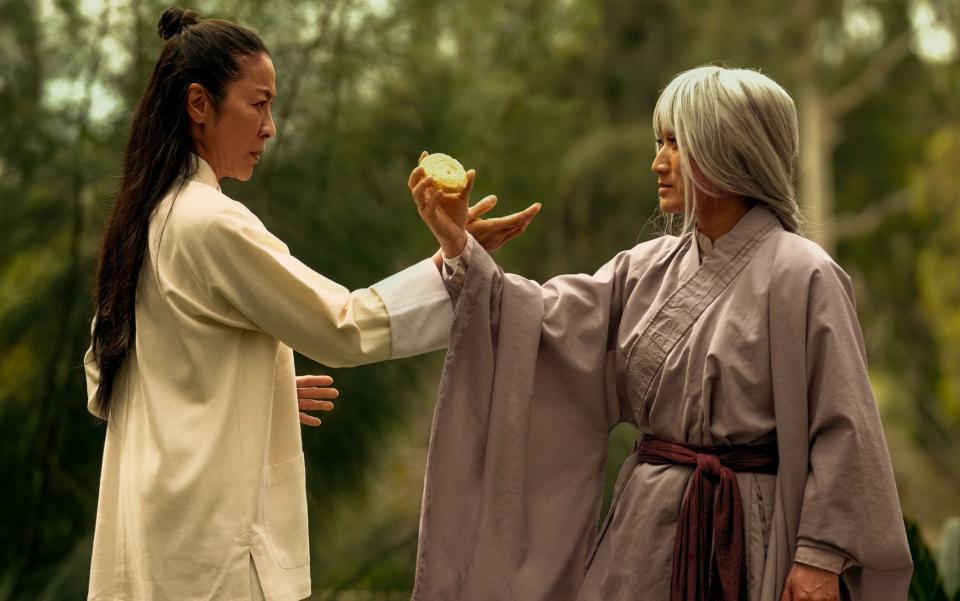How did a film as weird as Everything Everywhere All at Once win all those Oscars?

The Academy’s researchers are, at this moment, still cross-checking with the archives. But it’s currently believed this year’s Best Picture winner is the first in history to contain one, let alone two, fight scenes involving marital aids. Or a soul-searching conversation between two rocks with stick-on googly eyes. Or a parody of a Pixar film involving a taxidermied-looking raccoon. Or multiple interludes in which everyone’s fingers are hot dogs. In short, the 2023 Oscar champion is not your typical Oscar champion at all.
So how, in this universe or any other, could Everything Everywhere all at Once become the darling of the Hollywood establishment? Daniel Kwan and Daniel Scheinert’s film is one of the unlikeliest success stories in recent Oscar history: a scrappily madcap independent sci-fi martial arts comedy from two largely unknown directors in their mid-30s which swept the board on Sunday night, triumphing in seven categories including Best Picture and Best Actress for its star Michelle Yeoh.
In fact, having won in both of the supporting acting categories too, it became just the third film in Academy history to secure three acting prizes after A Streetcar Named Desire and Network. (None have yet managed all four.) It also won the most awards of any single film at the ceremony since Slumdog Millionaire took eight in 2009.
In other words, Everything Everywhere is now part of an exclusive club, and the speeches alone – all vintage Oscar night gush, expertly threading the needle between genuinely touching and absurdly OTT – will fit seamlessly into future montages.
“For all the little boys and girls who look like me watching tonight, this is a beacon of hope and possibilities,” said a tearful Yeoh, before adding: “And ladies, don't anybody tell you you're ever past your prime.”
“They say stories like this only happen in the movies,” glowed Ke Huy Quan, winning Best Supporting Actor early in the night.
“To all of the people who have supported the genre movies that I have made for all of these years…, we just won an Oscar together,” roared Jamie Lee Curtis, after making good on her first nomination after more than 45 years in the business. Later on, directors Kwan and Scheinert paid effusive tribute to their parents, while the former, in paying tribute to his cast and crew, supplied an instant classic Oscar humblebrag: “Thank you so much to everyone who has unlocked my genius.”
Yet as par for the course as all of the above may have been, the film itself was hardly preordained for Oscar glory. For a start, it is the first Best Picture winner in 16 years not to have premiered at what are widely seen as the five key award-incubating festivals: Cannes, Venice, Sundance Telluride and Toronto. Instead it first popped up at the Texas pop culture jamboree South by Southwest just over a year ago, and was almost sent straight to Sky Cinema in the UK until a few prominent industry champions convinced its American distributor, A24, to press ahead with a theatrical release.
They’ll be glad they did. After receiving mostly middling reviews from British critics – three stars in the Telegraph, two in the Guardian and four in the Times – Everything Everywhere all at Once went on to take £5.1 million over an 11-week run largely fuelled by positive word-of-mouth.
But its cult hit status over here was eclipsed by its success in the United States, where it made an extraordinary $73.3 million: this at a time when any title not tied to a franchise had to fight for its life in that market. (Not bad for a film made on a budget that was reportedly between just a tenth and a fifth of that – a sum which itself was rumoured to have been significantly rounded up, so as to avoid the film being seen as this year’s alternative, shoestring-made choice.)

In the end, the difference between the two nations’ embrace of the film was crystallised in its respective Bafta and Oscar tallies. At the former event last month? ten nominations, no wins. And at the latter last night? Eleven and seven, respectively.
On the far side of the Atlantic, why then did it strike such a chord? Cynics would suggest that reason one is its usefulness as a US culture-war talking point: it ticks every diversity box on the sheet. Young filmmakers, nonwhite stars, an Oscar-netting lead role of substance for a widely beloved yet professionally undervalued Asian actress in her 60s? Check, check and check again: Yeoh’s Best Actress coronation alone has given the Academy its first Asian winner of that award in 95 years.
And that’s certainly part of the picture. When anyone dares question its brilliance on social media – one Twitter detractor memorably branded it “craft beer Marvel” – the film’s social utility is a recurring theme in the ensuing pile-ons from its most vehement fans. But the whole truth is a little more nuanced.
Take the film’s plot, which is certainly outlandish: lots of jumping between different branches of the multiverse, and a deadly cosmic bagel that could destroy reality as we know it. But it also hinges on a very grounded tension between a hardworking first-generation immigrant, Yeoh’s Evelyn Wang, the owner of a struggling laundrette, and her surly US-born daughter Joy, played by Stephanie Tsu.
As such, it’s fundamentally another bittersweet American Dream film – a tradition that takes in everything from Sergio Leone’s epic Once Upon a Time in America to the classic Don Bluth animation An American Tail and 2021’s Best Picture-nominated Minari. But its use of the multiverse device, in which Evelyn skips in and out of her alternate destinies – a singer, a chef, a pizza parlour promoter, a martial-arts-queen movie star not unlike Ms Yeoh – puts a fresh spin on a story type that aligns with that old weatherproof US national myth.
Whisper it, but for all its hip flourishes and wacky gambits, the film is also politically centrist to the core: its happy ending involves both a mother-daughter reconciliation and a renewed determination from Evelyn to pay her business’s fair share of taxes. No chance of a voter split on ideological grounds here.

It also gave the Academy the comeback story it always loves. Much of this year’s talk of a triumphant return centred on Brendan Fraser, who won Best Actor for his role as a chronically obese father reconciling with his estranged teenage daughter in The Whale. But Everything Everywhere had Ke Huy Quan, the former child star of Indiana Jones and the Temple of Doom and The Goonies, who for two decades found it impossible to land Hollywood roles.
The film’s madcap multiverse conceit also gave it common ground with both the Marvel Cinematic Universe (which launched its current timeline-hopping plot arc around the same time) and the animated series Rick and Morty, which had long been a minor phenomenon on Cartoon Network’s late-night Adult Swim slot.
Wild as Everything Everywhere’s premise was, a mainstream US audience had already been primed for it – and just as Marvel fatigue was setting in, it felt like a glimpse from an alternate universe in which the blockbusters were all as imaginative, thoughtful and wit-packed as this. Watch and learn, Doctor Strange, quipped at least 50 percent of the reviews. This is how it should be done.


